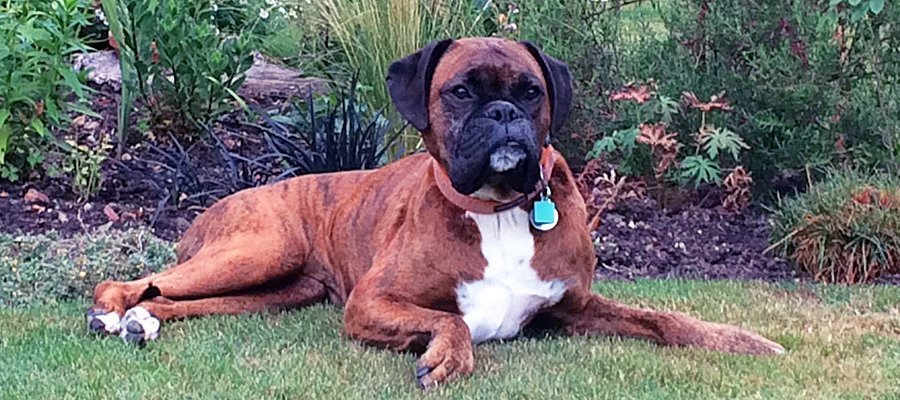Lovely Tilly suffers with a dog health condition, dysplasia in both of her hip joints.
Primarily an inherited condition, hip dysplasia is a common problem for all dog breeds, but is more prevalent in large/giant, fast growing breeds.
The condition results from an improperly formed hip joint (which is a ‘ball and socket’ joint), whereby the joint loosens with age. This means that the joint capsule and the ligaments that attach the femoral head (the ‘ball’) to the acetabulum (the ‘socket’) become stretched, as well as the tissues and muscles that would normally support the joint. The resultant joint looseness causes the articular surfaces of the femur and pelvis within the joint to lose contact with each other, eventually leading to partial dislocation of the hip(s). The knock on effect is a drastic change in the size and shape of the joint.
Because the joint is loose, the ‘ball’ is more free to move around, which in turn causes painful wear and tear to the joint. Unfortunately, this inevitably leads to secondary degenerative joint disease (DJD).
Hip dysplasia can occur in one hip, or in Tilly’s case, in both.
Causes
Hip dysplasia can be caused by a number of ways:
- Genetically acquired – inherited from the parents
- Rapid weight gain – the possibility of being affected the disease can be made worse by feeding a very high-calorie diet to young, growing dogs, because the rapid weight gain places increased load stress on the hips
- Being overweight
- Nutritional factors – a diet with an imbalance of calcium and phosphorous is not beneficial for healthy bone development
- Inappropriate exercise during period of rapid bone growth – young dogs should be discouraged from jumping up and down from heights, standing up on their back legs and should avoid running on potentially slippery surfaces
Symptoms
Dogs of all ages are subject to hip dysplasia and the resultant degenerative joint disease. DJD is part of the body’s way to attempt to stabilise the joint by reducing movement and therefore, pain. Unfortunately, it is certain that DJD will eventually progress as osteoarthritis and will manifest as painful inflammation of the joint. This is a problem that Tilly suffers with daily.
The symptoms of hip dysplasia depend on the degree of joint looseness, the degree of joint inflammation and the duration of the disease.
If your dog has hip dysplasia, they may have the following symptoms:
- Joint looseness – characteristic of early disease
- Resistance to movements that require full extension or flexion of the back legs
- Altered gait when walking or running (‘bunny hopping’). Also rotation of the hips in worst cases in an attempt to reduce extension of the hip joint (catwalk model gait). See the ‘Tilly walking’ video below for a good example of this.
- Intermittent or persistent hind-limb lameness which is worse after exercise
- Reluctance to climb stairs
- Reluctance to run or jump
- Decreased activity – the dog is less willing to participate in normal daily activities
- Stiffness and pain in the rear legs and hip joints after exercise or first thing in the morning
- Decreased range of motion in the hip joints
- Grating detected with joint movement
- Difficulty rising and may need assistance in getting up
- Loss of muscle tone and mass in thigh muscles as condition progresses
- Narrow stance in the hind limbs (back legs are unnaturally close together when standing)
- Front leg compensation – enlargement of and tension in shoulder muscles due to more weight being exerted on front legs as dog tries to avoid weight on its hips
- Displays of protective aggression due to painful extension of hip
Massage treatment for hip dysplasia
Massage will help with pain relief and compensatory muscle tension where the dog tries to stabilise the hip joint in the affected side, and other body areas, such as the back, shoulders and neck. Massage can be focussed on the lower back and bottom muscles, as well as the front of the back legs (quadricep muscles) and back of the legs (hamstring muscles). We would recommend early morning treatment (to loosen the everything up) and evening treatment (to relieve muscle tension buildup and general soreness).
Further treatment for balancing the muscles involved in pelvic posture is also beneficial, as well as an appropriate exercise regime, including hydrotherapy (Robertson and Mead, 2013).
Tilly’s owner is helping to ease her daily pain by carrying out simple massage treatments at home, building core strength through regular appropriate exercises, and utilising a Photizo vetcare to help reduce the inflammation associated with this condition.
We hope Tilly continues to make good progress!
Sources:
- ASPCA, 2014b. Hip Dysplasia. Available at: http://www.aspca.org/pet-care/dog-care/hip-dysplasia.
- Colville, T., Bassert, J.M., 2008. Clinical Anatomy and Physiology for Veterinary Technicians. 2nd ed. St. Louis: Mosby Elsevier.
- Foster and Smith, 1997-2013b. Hip Dysplasia in Dogs: Diagnosis, Treatment, and Prevention. Available at: http://www.peteducation.com/article.cfm?c=2+2084&aid=444.
- Houredebaigt, J-P., 2004. Canine Massage – A Complete Reference Manual. 2nd ed. Wenatchee: Dogwise Publishing.
- petMD, 1999-2014d. Hip Dysplasia in Dogs. Available at: http://www.petmd.com/dog/conditions/musculoskeletal/c_dg_hip_dysplasia?page=2.
- Robertson, J., 2010. The Complete Dog Massage Manual. Dorset: Veloce Publishing Ltd.
- Robertson, J., Mead, A., 2013. Physical Therapy and Massage for the Dog. London: Manson Publishing Ltd.
- WebMD, 2005-2014c. Hip Dysplasia in Dogs: Causes, Symptoms and Tests. Available at: http://pets.webmd.com/dogs/hip-dysplasia-dogs-causes-symptoms-tests.
